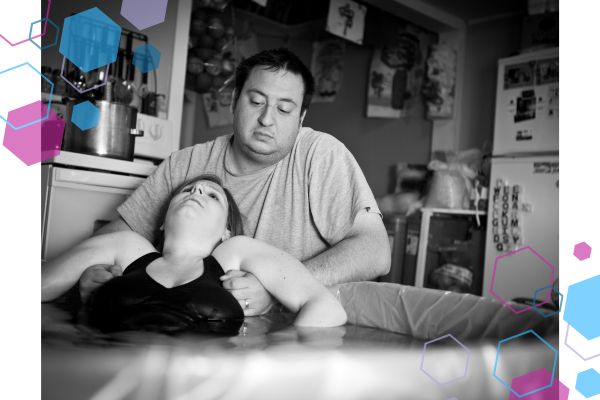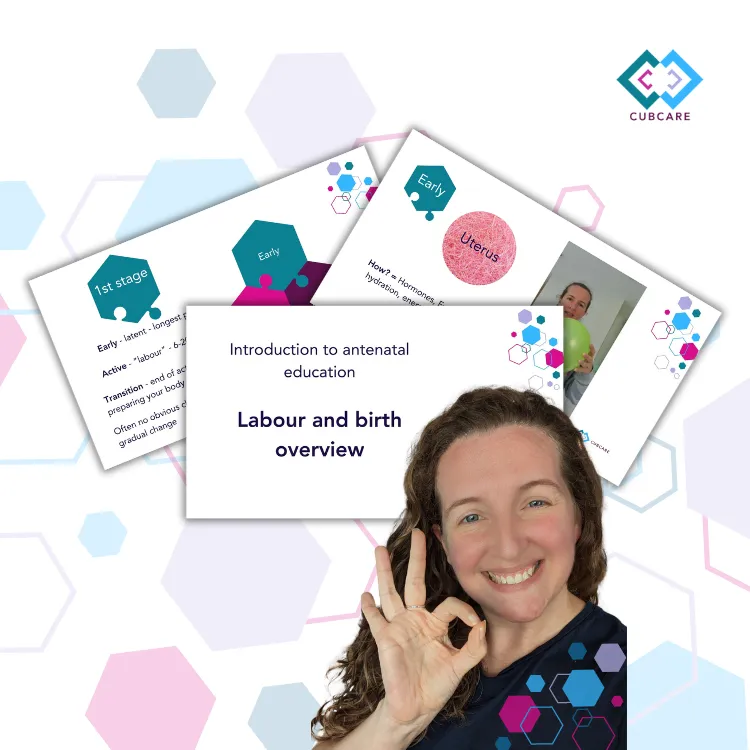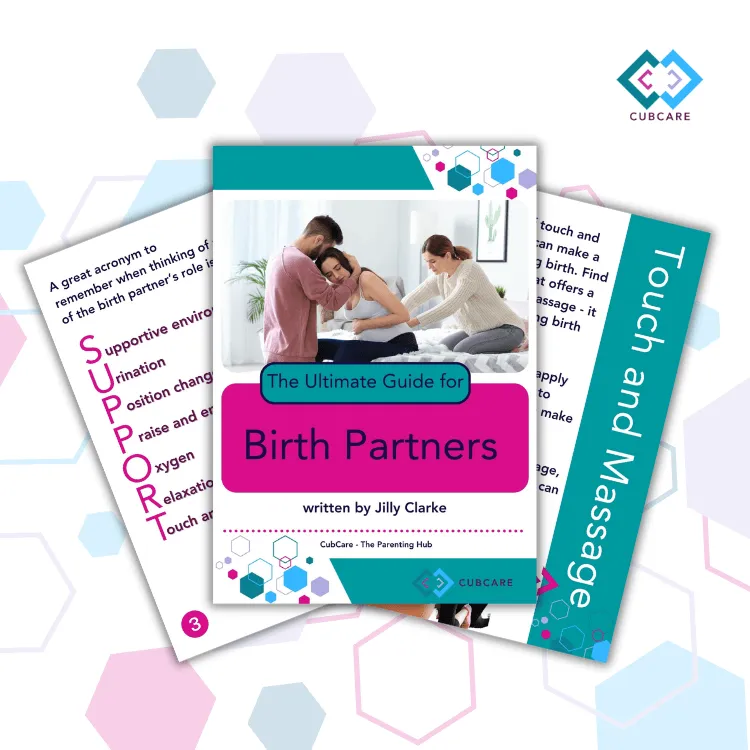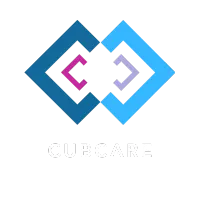We're an award winning Antenatal and Postnatal Education Platform 2025!
(read more here)
CubCare blogs.
From early pregnancy to newborn development.
Advice to help through pregnancy, birth and childhood.
BLOG

Ten alternatives to medical pain relief for labour
“Non-medical pain relief options and coping techniques are so useful to know. Self-help comfort measures are always there for you. A way to get through labour, or something to bring out whilst waiting for the drug to be administered, or whilst waiting for them to take effect.” - Jilly
What alternatives are there to medical pain relief for labour?
If you are reading this then you are probably preparing for birth – so huge congratulations being thrown your way!
You have come across this blog because you are looking for something to help you through your upcoming birth. Recognising that there must be another way, other than relying solely on medical forms of pain relief.
Birth IS a huge mental and physical undertaking. But it is something that film and television, and even the NHS (website, and quite possibly real life, depending on who you meet) will have you believe that you can’t get through without medical pain relief.
There are many, many alternative tools and techniques that you can use as alternatives, and even alongside medical pain relief options.
I am always telling my clients in my Antenatal Courses and in my Online Antenatal Courses that the techniques below are always there for you. Non-medical pain relief options and coping techniques are so useful to know. Self-help comfort measures are always there for you. A way to get through labour, or something to bring out whilst waiting for the drug to be administered, or whilst waiting for them to take effect.

Why would I want alternatives to medical drugs in labour?
You might be the type of person who is wondering why anybody wouldn’t take up all the medical forms of pain relief when it was offered. And that is totally ok, if understand the impact it can have on birth!
This certainly isn’t a post about avoiding medical pain relief at all costs! As long as you understand the impact that drugs have on your body, your birth and quite possibly your baby, and you understand the things you can do to avoid these potential outcomes – then absolutely go for it.
I am very much about choice.
And interestingly, the NHS web page on pain relief in labour does not fully go into the facts and impacts of the different pain relief options…
I’m about giving yourself enough strategies to deal with different things so that when the time comes you can confidently choose what’s right for you in the moment.
I’m about you understanding that choosing something (induction, pethidine, epidural, water, movement etc.) means that there will be an impact on something else. As long as you know what you might need to do to counteract these potential by-products, then go for it!
10 alternatives to medical pain relief during labour
1. Breathing techniques
Breathing sends more oxygen to your muscles, which helps them work more efficiently and with less discomfort. For birth, we’re talking about the uterus. But we’re also talking about the diaphragm, the core muscles and the pelvic floor. These all need oxygen to help them move efficiently.
A new 2023 systematic review of medical trials has concluded that “breathing exercise is a beneficial preventive intervention in shortening the duration of second stage of labour.”
A 2022 published study concluded that those who “receive continuous
support combined with breathing exercise during their active phase of labor exhibit faster progress of labor”
So – the evidence says that your labour can be shorter with breathing techniques!
As if that wasn’t enough… Slow, focused breathing also helps activate your parasympathetic system. This helps you relax. Research also backs this up, as it has been found that breathing can reduce anxiety in labour and birth.
Breathing is scientifically proven to give you a higher chance of a shorter and more relaxed birth.
2. Massage techniques
Massage and hold techniques can both boost endorphins (your body’s natural painkiller) and help to ease muscles.
Again, science backs this up! A recent 2020 study on the effectiveness of back massage for pain relief in labour found that compared to those who did not receive massage, it was effective at reducing pain in the first stage of labour.
This isn’t the only evidence of this either. A number of studies have found the same, or similar conclusions.
Massage works as part of the gate control theory for birth, by flooding the body with pleasant sensations so that the brain does not perceive the painful sensations as much. In other words, it blocks painful messages from getting to the brain because the brain is concentrating instead on all of the other sensations it’s feeling.
It releases oxytocin and endorphins into the body, promoting a calmer, relaxed feeling but also potentially speeding up labour!
A hip squeeze or low back press can help to make muscles move less distance, making them work less, easing discomfort.
Having a birth partner learn different techniques during pregnancy can make a big difference when the time comes.
This supportive birth partner can also play a big part in making labour easier too.

3. Movement
When you are in discomfort, you tend to move. Movement releases endorphins, helps your oxygen flow and relaxes muscles.
Yet again, science backs this up. “Walking and upright positions in the first stage of labour reduces the duration of labour, the risk of caesarean birth, the need for epidural, and does not seem to be associated with increased intervention or negative effects on mothers’ and babies’ well being.”
Movement also helps baby’s positioning, potentially making labour easier. Let your body move instinctively. Trust that you know what you need to do – because you absolutely do.
4. Aromatherapy
Studies have shown that aromatherapy can ease stress, tension and potentially reduce pain.
Specific scents work with your body to reduce your perception of discomfort and help to relax muscles.
You can learn different applications such as massage, inhalation, aromatherapy baths (or footbaths) and so many more options.
See if your antenatal classes cover these elements – if not book on to one of mine!
5. Environment
A low light, calm atmosphere will help boost oxytocin. Oxytocin will help the body to relax and will also inhibit the stress response – reducing your sensitivity to pain and discomfort. It will also increase contractions!
Can you in imagine going to the toilet in a room full of people? Being in labour and giving birth should be the same.
Private, safe, secure.
6. Visualisation
Visualising the end goal or the end of a contraction is a powerful technique to reduce tension.
Reminding yourself, and picturing of the purpose of each contraction is powerful.
7. Water
Warm water can provide fantastic relief from the intensity of contractions, by relaxing muscles. Studies have shown that using a warm pool can reduce the need for medical pain relief and can create a much more relaxing environment – again boosting those wonderful labour hormones!
Water can be used at home, during labour and/or delivery.
8. TENS Machine
A TENS machine is a great option to have on hand for early labour. Best used as early in labour as possible.
It provides a great distraction, it’s portable, and it helps to build you body’s own natural painkiller – endorphins.
T.E.N.S machines deliver mild electrical impulses through the skin to stimulate the
cutaneous (surface) and afferent (deep) nerves which helps control pain.
One theory why TENS machines work well is something called the gate control theory – essentially confusing the brain – flooding nerves with sensations so that contraction signals struggle to reach the brain.
9. Hypnobirthing
Hypnobirthing using a combination of many of the above elements to help ease sensations of birth.
The main techniques used in hypnobirthing are breathing, visualisation and relaxation, and can be incredibly powerful when combined together. But imagine combining more of these elements…what a powerhouse of a technique!
10. CubCare Antenatal Classes
And finally – the real deal.
Imagine learning a way to combine every single technique. Preparing during birth to ensure muscles, ligaments, your body, your baby and your brain are in agreement with each other. And learning all the proven techniques that can also help if you need them.
Imagine learning how medical pain relief can be beneficial, and when used with some thought, and a plan, can be a useful addition.
Imagine heading into labour with confidence and all the techniques in your back pocket to use if you need them?
But our bodies are SO capable. With the trust, the knowledge and the education you CAN have an amazing birth experience.
That's why we have our Antenatal Course (both in person and online), Refresher Antenatal Course (both in person and online), and our Birth Partner course so that everybody can get knowledgeable and confident for birth.
Refresher Antenatal Course in person
Refresher Antenatal Course online
Birth Partner course (included in our Antenatal course)
Antenatal Course in person
Antenatal Course online
Easily navigate to our most popular Blog categories
Download our Freebies

Labour and Birth
Watch our introduction to antenatal education webinar, our labour and birth overview - to start your antenatal education journey. Understanding the process, and what you can do to influence it.

Pregnancy Planner
Free Pregnancy Planner to help you prepare for a little one. Prepare your body, your mind, your finances and your home. Get organised, feel good and prepare for an active, positive birth.

Birth Partner Guide
Your ultimate guide to being the best birth partner during pregnancy, birth and recovery. Learn what you need to do, and what you need to learn to be the best birth partner possible.

Expecting Again Guide
Your ultimate guide to preparing for another birth and an extra baby. Our top tips for navigating pregnancy and birth, and helping your older ones to transition into their new role as a big sibling.
Based in Welwyn Hatfield, offering local pregnancy support and doula services across Hertfordshire: St Albans, Hatfield, Welwyn Garden City, Potters Bar, Stevenage, Harpenden, Hitchin, Barnet, Mill Hill and surrounding areas.
Online antenatal and postnatal education available UK-wide.
© Copyright 2025 CubCare The Parenting Hub. CubCare is operated by The Birth and Baby Company Ltd. Company No. 15655287
Privacy Policy | Terms & Conditions | Medical Disclaimer | Inclusivity and Accessibility

